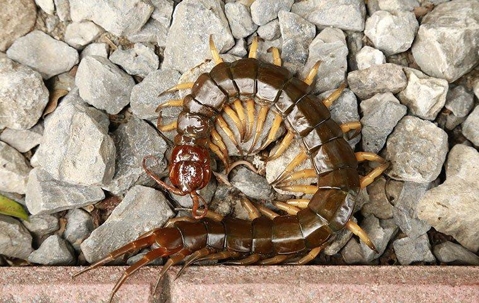Centipedes and millipedes are a problem for homeowners across the country, but they’re especially commonplace here in South Carolina. While millipedes are pretty much harmless, centipedes are a different story. They can inflict venomous bites that leave you with painful, swollen welts that might take days to heal. This ultimately won’t put you in life-threatening danger, but it can ruin your day, and it’s plenty enough motivation for most people to want to keep these venomous, many-legged buggers out of their homes.
Millipede Versus Centipede: Arthropod Fight Night
Many people don’t know the differences between centipedes and millipedes, so when they see a long, thin arthropod with tons of legs, they might not be able to tell what they’re looking at. The good news is that there are lots of ways to differentiate between centipedes and millipedes. One of the biggest ways is the number of legs. Millipedes have twice the number of legs that centipedes do. They have two pairs of legs per body segment, while centipedes only have one. Millipedes also have their legs positioned underneath their bodies, while centipedes’ legs jut out of their sides. Millipedes’ legs look like short, fine hairs, while centipedes’ are thicker and longer.
While millipedes are rounder and fatter in appearance, centipedes are more flattened out. To top it off, centipedes have long antennae and a rear pair of legs that look like a tail. Millipedes can also roll their bodies up into a tight coil if threatened, showing only their armored backs and protecting their vulnerable underbellies. Centipedes cannot do this, so it's a millipede if it rolls up like a roly-poly.
Despite their similar looks, centipedes and millipedes eat very different things. Millipedes are scavengers that like to feed on leaf litter and decomposing plants. They love moist environments with lots of easy pickings, which is why you frequently find them in the fall. They love to hang out under wet leaf piles. Centipedes, meanwhile, are predators that hunt insects, killing them with their venom before eating them. That means that millipedes are harmless, and it might even be a good thing to have a centipede or two stalking around in your crawlspace since they eat much worse pests than themselves. The problem arises when these many-legged creatures invade your home in large numbers.
The Pitter-Patter Of A Million Little Feet
Millipedes and centipedes prefer to stay outside under most circumstances. Centipedes will enter your home if you have an infestation of their favorite prey, and both these arthropods will come knocking if the weather turns foul. Cold temperatures, droughts, floods, and other unpredictable weather phenomena that come with the fall season can drive both millipedes and centipedes indoors. You can take measures to keep them out by:
- Sealing off cracks and holes in your home’s exterior with silicone caulk.
- Ensuring your window and door screens fit well and are free of rips and tears.
- Use caps or insect mesh over vents and other legitimate openings in your home.
- Installing weather stripping under doors and windows.
Unfortunately, the weather can make centipedes and millipedes desperate enough to find a way into your home, no matter how well you seal it. If that happens, you don’t have many options for dealing with an infestation yourself. These arthropods are great at hiding and tough to kill. That means you’re likely to need professional help. At Aiken Pest Control, we’ve dealt with centipede and millipede species endemic to the Southeast for over fifty years. If you’re ready to give your multi-legged houseguests the boot, give us a call or visit our contact page today and get started on our effective home pest control services.

